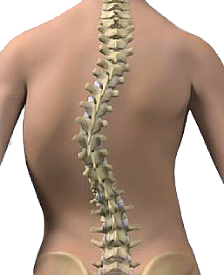Adult Scoliosis
 Scoliosis is a condition that causes an abnormal lateral curvature of the spine. A slight degree of curving is perfectly normal in most people, but scoliosis causes a pronounced curving of the spine resembling the letters “c” or “s.” Although this condition often develops during adolescence – during the growth spurt before puberty -, adults scoliosis can also develop in some cases.
Scoliosis is a condition that causes an abnormal lateral curvature of the spine. A slight degree of curving is perfectly normal in most people, but scoliosis causes a pronounced curving of the spine resembling the letters “c” or “s.” Although this condition often develops during adolescence – during the growth spurt before puberty -, adults scoliosis can also develop in some cases.
Adult scoliosis is most common in people between 50 and 80 years old. The lateral curvature of the spine is caused by degeneration of the spine’s facet joints which help the spine to bend and twist. The most common causes of adult scoliosis include:
- Degeneration due to the aging process
- Untreated childhood scoliosis
- Other conditions affecting the spine
Scoliosis Signs and Symptoms
To diagnose scoliosis, your doctor will perform a physical examination that will measure your range of motion, balance, reflexes, muscle strength, sensation and neurological function. Then, he/she will order X-rays to observe the curvature of your spine and to determine how fast the curve is progressing. MRIs and CT scans may be needed to determine the health of the discs above and below your curve and to conclude if there is nerve compression. The most common scoliosis symptoms and signs include:
- Curved posture
- Humpback
- Leaning towards one side
- Prominence of ribs
- Uneven shoulders
- Difficulty sitting or standing
- Difficulty walking
- Weakness, numbness, and pain in the legs and feet due to nerve damage
- Reduction in height
- Spinal stiffness
- Shortness of breath and fatigue (upper spine curve)
Scoliosis Treatment
Most scoliosis cases (approx. 90%) are moderate and do not require any treatment, but an ongoing observation by a specialist every 4 to 6 months. If the scoliotic curve is growing fast, orthopedic bracing is then recommended to reduce the progression of the curvature. If bracing is not effective, then a scoliosis correction surgery is recommended.
Scoliosis Correction Surgery
If surgery is needed to correct a spine curvature, the most recommended procedure is Spinal Instrumentation and Fusion. The procedure is performed by inserting pedicle screws and hooks at various points in the spine combined with rods in order to straighten the spinal curve. Then, the rods are locked into position and a bone graft is applied to create a fusion, so it can prevent further curve progression.
The main goals of a scoliosis surgery are to prevent the ongoing progression of the spinal curve, reduce the spinal deformity and help the spine to maintain the body balance.
Our Spine Surgeons have been performing scoliosis procedures for years in Boca Raton. For a preferred specialist in Boca Raton, call 561-549-9090.
